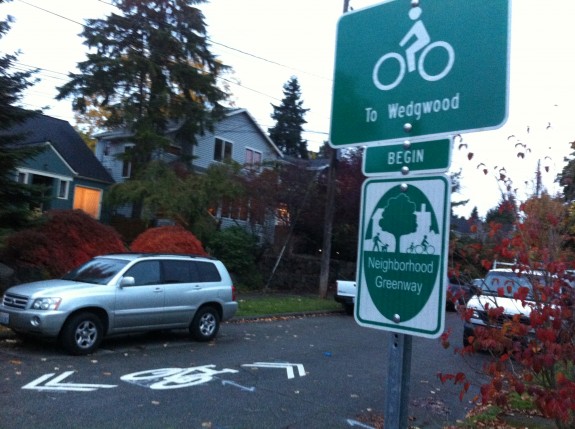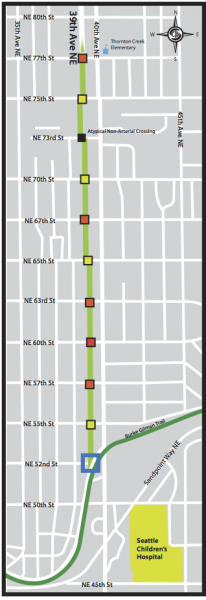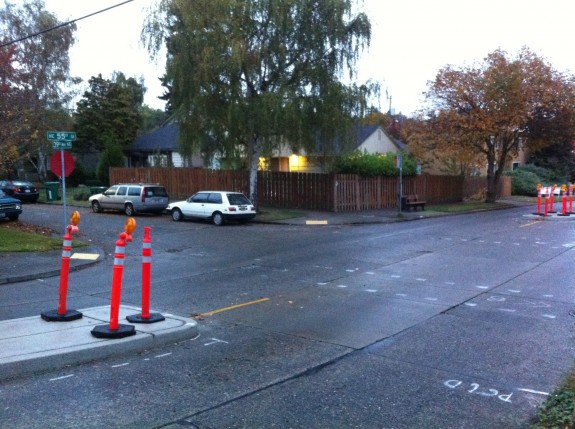
 Advocates and neighbors of the nearly-completed 39th Ave NE neighborhood greenway last week celebrated the upcoming completion of the Seattle Children’s funded 39th Ave NE neighborhood greenway connecting Wedgwood to the Burke-Gilman Trail.
Advocates and neighbors of the nearly-completed 39th Ave NE neighborhood greenway last week celebrated the upcoming completion of the Seattle Children’s funded 39th Ave NE neighborhood greenway connecting Wedgwood to the Burke-Gilman Trail.
The project, funded by Seattle Children’s Livable Streets Initiative, has the potential not only to make it easier and safer to bike in northeast Seattle, but also to demonstrate the potential of neighborhood greenways in Seattle.
If you are hoping to get a taste of the neighborhood greenway magic, however, you might want to wait just a little bit longer so crews can complete the project. While most of the costly aspects have been completed—such as the significant curb extensions where the road meets the Burke-Gilman Trail and the cement crossing islands at the arterial crossings—there is still a lot of important finishing work to do. Stop signs have yet to be installed on cross streets and many crosswalks and sharrows are not yet complete.
The project’s arterial crossings do not include traffic-diverting crossing medians, an element that has been proven effective in Vancouver and Portland, but that carries the potential for some neighborhood resistance. Once the stop signs go in for cross-traffic, neighbors and project boosters should pay attention to whether that increases the number of people driving on the street.
After all, the whole point of this project is to create a street that is safer and more inviting for all residents, including the active bike-to-school community already thriving there.
Cascade was at the opening celebration and took this video:









Comments
15 responses to “A look at the almost-completed 39th Ave NE neighborhood greenway”
Are these ‘greenways’ supposed to be safer for bicyclists? I feel safer riding on an arterial with marked bike lane or sharrows than on a greenway. In Wallingford, the greenways are on low traffic neighborhood streets but there are a lot of uncontrolled intersections one has to navigate. Neighborhood car drivers usually are careful at the uncontrolled intersections but most cars don’t slow down — they just drive through. I don’t believe the greenways are worth the investment. Note that I have not evidence to support this, just an opinion.
The Wallingford greenway is not really the best example. This 39th Ave one will be much better and more useful, in my opinion, due to the connection with the trail, the fact that it goes where few other good bike routes go, and the stop signs on cross streets they plan to add.
The Wallingford greenway is really mostly useful for nearby residents and will remain such until safe and easy connections across Aurora and I-5 are created. There’s also pressure to add stop signs at the existing traffic circles to make them safer. I’m not sure if that will happen there anytime soon, but plans for future routes so far have included them (a lesson learned, it seems).
The main point, though, is that many people simply do not feel comfortable biking on a busy street, even with a painted bike lane. And even if they do feel comfortable, they might not feel the same for their children. The three solutions we have are to build trails like the Burke (not an option for most situations), build protected cycle tracks on busy streets (sometimes expensive, but the idea is gaining momentum) and making our neighborhood streets safer and more convenient (AKA neighborhood greenways). Seattle will need a mix of all three.
The concept behind the greenways is not entirely about creating safer biking and walking routes. It’s also about place-making. It’s a way of creating a special street that feels more like a park or a trail, engaging the neighborhood to make it a special street that somehow represents them (whatever that means). At least that’s the idea.
I ride on side streets, arterials, and bike paths, and I think we need all of them. There’s no question that arterials are where you want to be if you’re going fast. They’re designed for fast-moving traffic and have the necessary sight lines and traffic control devices so you don’t have to slow down at every cross street. But even as a fairly experienced and fairly fast rider, being passed by cars at high speed can be stressful, particularly on descents (I generally take the lane on descents to minimize this, but still some drivers do so, often in stupid and risky ways). On side street routes I can go as slow as I want without getting passed, and staying safe at uncontrolled intersections and roundabouts is simple at low speeds — it requires no special skills or awareness, just the caution that the street environment implicitly encourages. By putting up signs pointing out nice side street routes we can encourage biking that doesn’t add undue stress to people’s lives.
Good points, Al. However, often, I find the busy streets aren’t actually faster than the side streets. It depends on the neighborhood, but since side streets rarely have stop lights, you can often get to your destination faster or at the same time by trading some top speed for fewer complete stops and waits. With stop signs controlling cross-street traffic on all but the busy streets, neighborhood greenways could be even faster.
As sombody who uses that stretch of 75th all the time, I was really puzzled by what I was looking at here. What are these concrete dealies in the street supposed to be good for? When you’re headed southbound on 40th, there’s a pretty good hill, so you’re just blowing along at 30mph(ish) along with all the rest of the traffic anyway. Why move to 39th instead? Maybe this is useful for heading northbound? As pointed out elsewhere, those uncontrolled crossings are near-suicidal for car vs bike. Is there some webpage that lays out the basic argument for this design?
As the post states, much of it is not complete yet. Among the missing elements: Stop signs for the intersections. They’re coming soon, though.
For more on neighborhood greenways, see the Seattle Neighborhood Greenways website: http://seattlegreenways.org/who-we-are/what-are-greenways/
and this video:
at=0
I find it unlikely for many kids (or myself for that matter) to be biking at 30mph on 40th, but there are many kids who bike to school on 39th. That’s just one demographic who will prefer 39th to 40th. If 40th works better for you, by all means, stay with it. It’s exciting to see the network expand to serve more people who want to ride a bike to get around. Hopefully, this kind of road treatment will be inviting to people who aren’t interested or able to ride fast with traffic.
Seattle and those cursed uncontrolled intersections! Perhaps the more people actively use the street for walking, biking, running, skate-boarding, etc., the more everyone will be aware of each other’s presence and slow down and yield in neighborhoods.
As for the concrete dealies in the street, they’re part of SDOT’s half-assed design for greenway-arterial intersections. Other cities use full diverters, but in Seattle our department of transportation never rests in finding new, innovative bike infrastructure that puts cyclists right in the way of drivers. Want downhill-direction bike lanes in front of dangerous driveways? Mode separation through arterial intersections (precisely when traffic should be direction-separated)? Concrete dealies that look sort of like diverters but neither divert traffic nor allow for safe two-stage crossing? Call SDOT today!
[…] will someone email me once the 39th Ave NE greenway is finally finished? I mean, we had the ribbon cutting ceremony in October, and it’s still not […]
[…] first new-era neighborhood greenway on N 44th/43rd Streets. Nearby, another neighborhood greenway recently opened on 39th Ave NE thanks in large part to Seattle Children’s, which has more livable streets work on the way […]
[…] of health care outside as well as inside their institution’s walls. This year also saw the completion of the 39th Ave NE neighborhood greenway connecting Wedgwood to the Burke-Gilman Trail, passing the expanding Seattle Children’s […]
[…] most measures, the 39th Ave NE project was the city’s first truly successful experiment with neighborhood greenways. Funded by […]
[…] 39th Ave NE was among the city’s earliest neighborhood greenways and was the first to really show what neighborhood greenways can do for Seattle neighborhoods. However, they had not yet perfected […]
[…] leadership in northeast Seattle while at Seattle Children’s, helping to lead efforts to build one of the city’s first neighborhood greenways on 39th Ave NE. That greenway was just part of a $2 million investment the institution made in […]
[…] 39th Ave NE neighborhood greenway was among the city’s first good tries at such a facility, and it was mostly successful. But there are some things SDOT has learned since […]